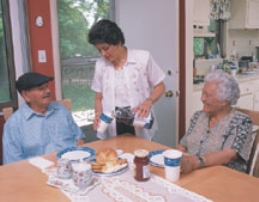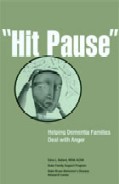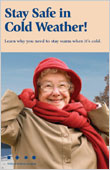
Contents
100 Years Ago...
 The year 2006 marked the 100th anniversary of Dr. Alois Alzheimer’s presentation of a case study of a 51-year-old German woman, Auguste D., who had been admitted to a hospital in 1901 with an unusual cluster of symptoms. Those symptoms included reduced comprehension and memory, aphasia, disorientation, unpredictable behavior, paranoia, auditory hallucinations, and pronounced psychosocial impairment. When Dr. Alzheimer first observed her in 1903, Auguste D. was bedridden, incontinent, and was becoming increasingly disoriented, delusional, and incoherent. She eventually required assistance to be fed, was unable to speak, and was often hostile. Hospital staff tried to keep her as safe and comfortable as possible, but little else could be done to treat her illness, and she died on April 8, 1906.
The year 2006 marked the 100th anniversary of Dr. Alois Alzheimer’s presentation of a case study of a 51-year-old German woman, Auguste D., who had been admitted to a hospital in 1901 with an unusual cluster of symptoms. Those symptoms included reduced comprehension and memory, aphasia, disorientation, unpredictable behavior, paranoia, auditory hallucinations, and pronounced psychosocial impairment. When Dr. Alzheimer first observed her in 1903, Auguste D. was bedridden, incontinent, and was becoming increasingly disoriented, delusional, and incoherent. She eventually required assistance to be fed, was unable to speak, and was often hostile. Hospital staff tried to keep her as safe and comfortable as possible, but little else could be done to treat her illness, and she died on April 8, 1906.
 Dr. Alzheimer used the latest medical techniques and innovations, including a new silver tissue-staining method and greatly improved microscopes, to conduct the post mortem study of Auguste D.’s brain tissue. No stranger to the fields of pathology and psychiatry, Dr. Alzheimer was involved in a wide range of clinical studies of manic depression and schizophrenia. He worked at the Royal Psychiatric Clinic in Munich, Germany, for Dr. Emil Kraepelin, a leading psychiatrist. Dr. Kraepelin believed that most mental illnesses were actually organic brain diseases, as opposed to his rival, Dr. Sigmund Freud, who maintained that most mental illnesses were psychoses of the mind. Dr. Kraepelin’s Handbook of Psychiatry, was the first systematic classification of mental diseases.
Dr. Alzheimer used the latest medical techniques and innovations, including a new silver tissue-staining method and greatly improved microscopes, to conduct the post mortem study of Auguste D.’s brain tissue. No stranger to the fields of pathology and psychiatry, Dr. Alzheimer was involved in a wide range of clinical studies of manic depression and schizophrenia. He worked at the Royal Psychiatric Clinic in Munich, Germany, for Dr. Emil Kraepelin, a leading psychiatrist. Dr. Kraepelin believed that most mental illnesses were actually organic brain diseases, as opposed to his rival, Dr. Sigmund Freud, who maintained that most mental illnesses were psychoses of the mind. Dr. Kraepelin’s Handbook of Psychiatry, was the first systematic classification of mental diseases.
The first “Alzheimer’s” case was presented at a meeting of the South-West German Society of Alienists (“alienists” were superintendents of early “insane asylums” and were usually psychiatrists) on November 3, 1906. Dr. Alzheimer’s paper, “Regarding a Curious Disease of the Cortex,” described numerous globs of sticky proteins in the spaces between neuron cells and “a tangled bundle of fibrils” within cells throughout the cortex.
These sticky proteins (plaques) and fibrils (tangles) had previously been seen only in the brains of much older patients diagnosed with “senile dementia.” At age 51, Auguste D. was thought to be far too young to be suffering from senile dementia, and Dr. Alzheimer’s “new” disease was initially classified as “presenile dementia.” Because of her age, clinicians did not consider the possibility that the plaques and tangles Dr. Alzheimer described could also be the cause of dementia in old age, thus the characterization as presenile dementia.
Dr. Alzheimer and his colleagues studied the histology of 5 cases with similar brain pathologies during the first decade of the new century. Although other researchers had linked the presence of plaques to symptoms of dementia seen in older people, it was Dr. Alzheimer who first observed both plaques and tangles in a younger patient.
It was not until 1910 that the term “Alzheimer’s disease” was coined by Dr. Kraepelin in his 8th edition of the Handbook of Psychiatry. He stated that “a particular group of cases with extremely serious cell alterations was described by Alzheimer…the plaques were excessively numerous and almost one-third of the cortical cells had died off. In their places, were peculiar, deeply stained bundles of neurofibrils.” He mentioned “Alzheimer’s disease” for the first time, stating, “The clinical interpretation of this Alzheimer’s disease is still unclear. Although the anatomical findings suggest that we are dealing with a particularly serious form of senile dementia, the fact is that this disease sometimes starts as early as in the late forties.”
In 1912, Dr. Alzheimer accepted an appointment as full professor of psychiatry at the University of Breslau (now Wroclaw, Poland), but his health deteriorated, and he was never able to fully carry out his university duties. From October 1915 onward, Alois Alzheimer became increasingly ill and finally died on December 19, 1915.
“In his day, Dr. Alzheimer’s discoveries were enormous strides forward. I believe that, just as Drs. Alzheimer and Kraepelin established the clinical pathways for researching this disease 100 years ago, we are creating strong foundations—in neuroimaging and genetics in particular—for the major discoveries to come,” commented Richard A. Hodes, M.D., Director, NIA. “Tremendous progress continues every day toward our efforts to conquer this disease.”
“Many of the world’s premier scientific thinkers are exploring every aspect of this highly complex disease. We’re discovering new information on AD’s earliest preclinical phases and intriguing insights into connections with other diseases and conditions,” said Marcelle Morrison-Bogorad, Ph.D., Director, Neuroscience and Neuropsychology of Aging Program, NIA. “New research is examining potential preventive mechanisms, molecular sequences, treatment, and caregiver interventions. Though pleased with our achievements, we’ll never be satisfied until we find a cure and ways to prevent the disease altogether.”
Back to top
A Century of Research
1900s
- Dr. Alois Alzheimer presents case study and Alzheimer’s disease is named.
1920s
- Amyloid is identified as the core substance of plaques.
1930s
- Familial AD is first suggested.
1940s
- Belief persists that senile dementia is normal part of aging caused by cerebral arteriosclerosis.
1950s
- Biological structure of plaques and tangles is investigated.
1960s
- Landmark study suggests that dementia is directly related to the number of senile plaques present in the cerebral cortex.
- Structure of neurofibrillary tangles is described as “paired helical filaments.”
1970s
- National Institute on Aging is created and assumes lead role in AD research.
- Mini-Mental State Exam is introduced.
- Memory and cholinergic function are linked; reduction of choline acetyltransferase is seen in AD.
- Editorial describes AD as a major public heath problem and “Alzheimer’s disease” becomes a common term.
- Coalition of grass-roots AD advocacy groups begins to rally public awareness of and interest in AD research.
1980s
- National Institute of Neurological and Communicative Diseases and Stroke/Alzheimer’s Disease and Related Disorders Association (NINCDS-ADRDA) criteria are written.
- Alzheimer’s Disease and Related Disorders Association forms, becomes the Alzheimer’s Association.
- First Alzheimer’s Disease Research Centers are funded by NIA.
- Diagnostic and Statistical Manual of Mental Disorders (DSM III) categorizes AD.
- Clinical Dementia Rating (CDR) scale is established.
- Consortium to Establish a Registry for Alzheimer’s Disease (CERAD) is created by NIA.
- AD is linked to chromosome 21 and amyloid precursor protein.
- Beta-amyloid protein is sequenced.
- NIA forms the Alzheimer’s Disease Education and Referral (ADEAR) Center.
1990s
- FDA approves tacrine (Cognex) following successful clinical trial.
- NIA funds Alzheimer’s Disease Cooperative Study.
- First amyloid precursor protein (APP) mutation is discovered.
- Early-onset genes and late-onset risk factor gene are discovered.
- First in series of transgenic mice models is created.
- Abnormal tau in neurofibrillary tangles is identified.
- NIA-Reagan criteria for AD pathology diagnosis are developed.
- Mutation in tau gene is cause of some chromosome 17 frontotemporal dementia.
- National Alzheimer’s Coordinating Center is formed.
- Mild Cognitive Impairment (MCI) characteristics are defined.
2000s
- Clinical trials, initiatives, and studies examine cholinesterase inhibitors, anti-inflammatories, vitamins, statins, supplements, valproate, antioxidants, hormones, beta amyloid vaccines, and alternative medicines.
- Late-onset Alzheimer’s Disease Genetics Study begins.
- Alzheimer’s Disease Neuroimaging Initiative is launched.
- Pittsburgh B compound is developed, allowing researchers to “see” amyloid plaques in PET scans.
- Triple transgenic mouse is introduced.
- New focus on translational studies to facilitate drug discovery and development begins.
|
Back to top
NIH AD conference helps set course for future research
During the recent National Institutes of Health AD conference—AD: Setting the Research Agenda a Century after Auguste D.—nearly 200 leading investigators interspersed a series of presentations with lively discussion sessions. Organizers chose this important centennial anniversary of Dr. Alzheimer’s presentation of the case of Auguste D. at a scientific meeting to ask speakers to provide an overview of the status of current research from their particular perspectives and to articulate the critical questions and issues that need to be addressed for continued progress in AD research.
The National Institute on Aging, which leads the federal effort supporting AD research, will use these insights and recommendations to guide its plans and priorities over the next few years.
Presenters discussed familiar topics, such as the role of beta-amyloid and tau, the use of animal models, genetic and environmental risk and protective factors, the relationship between AD pathology and clinical manifestations, neuroimaging, neuropsychological evaluations, drug development, and clinical trials.
They also focused on emerging areas of interest, such as vascular mechanisms at work in AD, the relationship of normal age-related changes to changes in AD, the use of biomarkers to track disease progression, common mechanisms among neurodegenerative diseases, and the role of neural networks in modulating the effects of AD pathology.
The presentations, discussions, and recommendations reflected a growing appreciation among these experts of just how complex a disease AD is. Many factors interact over many years to cause the development of AD, and as a result, it is likely that multiple approaches will be necessary to manage, treat, and prevent the disease.
The conference was cosponsored by the Neuroscience and Neuropsychology of Aging program of the NIA, the National Institute of Neurological Disorders and Stroke, the National Institute of Mental Health, the National Institute of Biomedical Imaging and Bioengineering, and the National Institute of Nursing Research.
International Events Commemorate the 100th Anniversary...
- Augusta’s File, on August 24, 2006, at the University of California at Irvine, which was a play telling the story of Dr. Alzheimer and his patient.
- Celebrating 20 Years of Alzheimer’s Research, on September 28, 2006, at the University of Pittsburgh.
- Dementia Care of Older Adults, on October 5-6, 2006, at the University of Michigan.
- 22nd Conference of Alzheimer’s Disease International, on October 14-16, 2006, in Berlin, Germany.
- 2006 International College of Geriatric Psychoneuropharmacology 6th Annual Meeting on October 3-6, 2006, in Hiroshima, Japan.
- AD: Setting the Research Agenda a Century after Auguste D. on October 26-27, 2006, in Bethesda, Maryland.
- Alzheimer: 100 Years and Beyond, Centenary Meeting, on November 2-5, 2006, in the auditorium of the Clinic for Psychiatry at the University of Tübingen, Germany.
- Reflecting on 100 years of Alzheimer’s, on November 6-7, 2006, at Case Western Reserve University, Cleveland, Ohio.
- The Many Faces of Dementia: The Journey from Science to Service, scheduled for February 23, 2007, at the University of Southern California Alzheimer’s Disease Consortium, in Los Angeles, California.
Back to top
AD Lib launched
Improves Literature Searching
The ADEAR Center has launched a new interface for searching the Center’s extensive collection of health literature on AD called AD Library or AD Lib. Visit AD Lib online at www.nia.nih.gov/Alzheimers/Resources/SearchHealthLiterature. In designing AD Lib, ADEAR staff made the search function easier and more powerful. AD Lib also fully integrates the AD Thesaurus, which contains more than 2,000 index terms, as a tool for users to browse the collection.
An outgrowth of the Alzheimer’s subfile of the now discontinued Combined Health Information Database (CHID), AD Lib includes fact sheets, textbook chapters, journal articles, brochures, teaching manuals, directories, videos and other media, bibliographies, program descriptions, monographs, newsletters, and reports that are available from a wide variety of sources.
Many of these materials are not found in other libraries or databases.
Back to top
Encouraging Eating: Advice for At-Home Dementia Caregivers
Second of two parts
Food, eating, and mealtimes are important parts of life. Food gives us life-sustaining nourishment and contributes to good health, eating satisfies our hunger and stimulates our senses, and mealtimes can be important sharing and social times with family and friends. Many of our favorite experiences and memories—preparing and sharing holiday dinners with family members, celebrating birthdays and other life events with special meals, and  getting together with friends for lunch or dinner, for example—involve eating and food.
getting together with friends for lunch or dinner, for example—involve eating and food.
When a person has Alzheimer’s disease or another type of dementia, though, the ability to prepare meals and eat independently may diminish, and mealtimes can become challenging, frustrating encounters for both the individual and the caregiver. Often, too, the person with dementia may be experiencing changes, such as decreased appetite, that are part of normal aging. Combined, these changes can lead to malnourishment and dehydration, increasing the risk of infections, poor wound healing, abnormally low blood pressure, and other problems.
Good nutrition cannot always prevent weight loss in people with Alzheimer’s disease, nor will it slow the progression of dementia.  However, continuing to eat a healthful diet can promote overall health, improve the person’s ability to cope, help prevent some physical and behavioral problems, and most of all, contribute to higher quality of life. Family members and paid caregivers of people with AD play an important role in both encouraging eating and identifying eating-related problems that could be resolved. This article discusses some of the eating-related challenges associated with the middle stages of AD and related dementias, and suggests mealtime strategies and tips for at-home caregivers.
However, continuing to eat a healthful diet can promote overall health, improve the person’s ability to cope, help prevent some physical and behavioral problems, and most of all, contribute to higher quality of life. Family members and paid caregivers of people with AD play an important role in both encouraging eating and identifying eating-related problems that could be resolved. This article discusses some of the eating-related challenges associated with the middle stages of AD and related dementias, and suggests mealtime strategies and tips for at-home caregivers.
Understand the Challenges
As people age, their interest in eating and mealtime enjoyment can change. Some older adults find that their senses of taste or smell decrease, making food seem less appealing than it did in the past. Others eat less because of difficulties chewing or digesting as they get older. Medicines can also affect appetite, and constipation may increase with age or medication use. When a person has AD or other dementia, these problems can become more pronounced, and mood, behavioral, and physical functioning problems may  affect eating as the disease progresses.
affect eating as the disease progresses.
“When the brain is involved, as in dementia, any part of seeing, thinking, or moving can be affected—from problems seeing the food clearly to difficulty planning the movement of scooping with a utensil and bringing food to one’s mouth. These problems can take the pleasure out of eating,” explains Sue Coppola, MS, OTR/L, BCG, clinical associate professor of occupational therapy and core interdisciplinary team member with the Program on Aging at the University of North Carolina at Chapel Hill.
Coppola and other dementia-care experts stress the value of caregivers not only understanding the degenerative nature of dementia but also recognizing that dementia varies from person to person. In the early stages of AD, challenges may be limited to the person skipping meals or forgetting to eat or forgetting that he or she has eaten. However, other eating-related difficulties and  patterns—from not sitting down long enough for meals to spitting out food or refusing to eat—can arise in the middle and late stages.
patterns—from not sitting down long enough for meals to spitting out food or refusing to eat—can arise in the middle and late stages.
“All of a sudden, the person might not eat, but it’s not because he or she is being difficult on purpose,” says occupational therapist Carol Bowlby Sifton, BScOT, founding editor of Alzheimer’s Care Quarterly and a care and staff training consultant at King’s Regional Rehabilitation Centre in Nova Scotia. “Caregivers need to understand that it’s the same person as before, but because of the complexity of the process of eating, the person may be confused and embarrassed, and thus refuse to participate. It might be easier for the person to withdraw from the activity than to make mistakes.”
For people with AD and related dementias, eating-related challenges can result from:
- cognitive issues, such as inability to express one’s needs or desires, initiate or persist with eating, use utensils, remember to eat, and distinguish the food from the plate (visual-perceptual challenges);
- behavioral and psychosocial issues, such as depression, distress, excessive pacing that may increase calorie use, and having difficulty sitting down for meals;
- physical problems, such as inability to hold and use utensils properly or maintain appropriate posture; fatigue; tremors; vision impairment; decreased depth perception; mouth sores; gum disease; dry mouth; poorly fitting or missing dentures; chewing or swallowing problems (dysphagia), and inability to move food inside the mouth;
- environmental issues, such as extraneous noise or confusion, too much visual stimulation, poor lighting, glare, unpleasant odors, and uncomfortable room temperature;
- food and menu-related concerns, such as having too
 many food choices at one time; difficulty eating the foods that are offered; unappealing food presentation, smells, flavors, or textures; and foods that are different from the individual’s personal, cultural, or religious food preferences;
many food choices at one time; difficulty eating the foods that are offered; unappealing food presentation, smells, flavors, or textures; and foods that are different from the individual’s personal, cultural, or religious food preferences;
- chronic diseases that decrease appetite, such as diabetes, intestinal, and cardiac problems;
- decreased appetite from use of certain medications or food-medication interactions;
- caregiver burden due to stress or lack of time, causing the caregiver to feel impatient or find it difficult to ensure that the person eats enough.
Assess the Situation
Assessing the mealtime situation can help caregivers identify and resolve problems and understand what is happening from the care recipient’s perspective. “The caregiver should take time to sit back and watch—really observe—what is going on when the person attempts to eat,” Coppola suggests. “As you’re observing, think about what is happening with all of the senses. Ask yourself which part of the task might be difficult and what the person is feeling. Is the person enjoying the meal, and if not, why not?”
When observing the situation, family members and other caregivers can assess:
- the visual aspects of the environment—for example, whether there is poor room lighting, too much glare or too many shadows in the room or on the table, unneeded items or too many food choices on the table, distracting patterns in the place setting, or too little color contrast between the food and the dishes;
- the sounds and noise in the environment—whether there are distractions coming from people talking, the television or radio, the refrigerator humming loudly, or dogs barking in the background;
- how the food smells, tastes, and feels;
- how well the person manages the mechanics of eating, from grasping utensils to identifying and picking up food to chewing and swallowing;
- the emotional climate in the room and how the person interacts with and responds to others in the room.
For everyone, nutritional needs shift as a person’s activity level changes. Therefore, it is important for the caregiver to note whether the person is eating and drinking enough, or, in the earlier stages of the disease, eating too much. The caregiver should monitor the person’s weight and eating habits to assess the care recipient’s nutritional intake and any nutrition-related issues. Caregivers should pay particular attention to:
- how much and what kinds of foods and fluids the person consumes over the course of each day,
- what times the person tends to be hungry,
- weight changes,
- appetite changes,
- problems with chewing or swallowing,
- how physically active the person is daily.
This information can be shared with the physician to determine whether the person is eating and drinking the right amount, relative to his or her activity level. The physician may recommend keeping a daily food and hydration diary. The information can help identify new physical or medical problems that may not be related to dementia but cause weight changes. “Assess the situation before moving to the next step,” Coppola says. “It’s important to know how much the person is really eating and how active he or she is before worrying or making changes.”
View Mealtimes as Opportunities
Dementia-care experts acknowledge that mealtimes can be stressful for caregivers and care recipients alike, but say that some of the typical challenges can be overcome by viewing eating as an opportunity rather than a task to “get through.”
“Mealtimes are one of the most important temporal anchors that people with Alzheimer’s have, marking morning, mid-day, and evening each day. Unfortunately, some caregivers dread the challenge of ‘getting the person to eat,’ and as a result, the experience for everyone can become negative and confrontational,” Coppola says. “Rather than being akin to a ‘medication time,’ mealtime can be seen as opportunities for a successful experience for the person because it’s an activity that is familiar, is overlearned, and can be modified in many ways.”
Mealtimes are opportunities for people with dementia to make choices, to have their identities reinforced, and to be affirmed for past accomplishments through statements such as “Mom, you make the very best biscuits!” or “You taught me to make pie.”
“Mealtime provides a time to be with other people,” adds Coppola. “Caregivers often have busy lives, and meals bring people ‘in the moment,’ creating a time to connect with each other.” For instance,  caregivers can help create a pleasant, social dining environment by talking about the food or reminiscing about family traditions and celebrations.
caregivers can help create a pleasant, social dining environment by talking about the food or reminiscing about family traditions and celebrations.
Experts further recommend integrating people with dementia into the entire mealtime process by encouraging them to help prepare the food, set the table, pull out the chairs, or put the dishes away. Doing so helps the care recipient experience eating in a larger social context and as part of daily activity, rather than as an isolated task. Moreover, participating in the mealtime process helps the person maintain functional skills and feelings of personal control.
“Think about the mealtime-related activities the person did in the past and modify them as needed so he or she can continue to contribute to the family. Keep your eye on the process, not the product, because it’s the activity, not the outcome, that counts,” says Cynthia Epstein, ACSW, a clinical social worker at the New York University Silberstein Aging and Dementia Research Center.
Promote Independence
Caregivers can use a variety of strategies to promote independence during mealtimes. For example, if the person lives alone, the caregiver might call and remind the person to eat a meal, write down simple step-by-step directions about how to prepare a particular meal, or organize the kitchen so that items needed for a simple meal are in view.
If the care recipient has difficulty using utensils, replace some foods with finger foods such as small sandwiches, cheese, hard-boiled eggs, and fresh fruits and vegetables. Simple adaptive eating tools also can help some people remain independent and maintain a sense of personal control while dining. These include items such as plates with large rims, cups with lids and wide bases, flexible  straws, utensils with large or built-up handles, and non-slip placemats or suction cups to keep dishes from moving on the table. Adaptive tools that look familiar can help trigger the person’s memory for eating.
straws, utensils with large or built-up handles, and non-slip placemats or suction cups to keep dishes from moving on the table. Adaptive tools that look familiar can help trigger the person’s memory for eating.
In addition, visual, verbal, sensory, and physical cuing can promote independence, especially when the cues are based on lifelong habits. Coppola recommends starting with visual cuing, which can be as simple as eating with the person as a reminder that it is mealtime. Place utensils in the positions in which they will be used. Dishes that are different colors from the food help the person distinguish the food.
Clear, easy-to-understand verbal prompting may also be needed. Depending on the person’s language ability, this may mean giving very specific, step-by-step directions, or it may mean offering simple choices, such as “Do you want peaches or apples?” or “Would you like cream in your coffee?” Verbal prompts, such as “Do you think the beans have enough salt?,” can focus the person’s attention on the food.
Sensory cues, especially those involving smell, can let the person know it is time to eat. Sifton notes that nothing ‘says’ mealtime and triggers the appetite more than aroma of soup or stew simmering on the stove or something baking in the oven. Even the smell of toast can help.
People with more advanced dementia may also need physical prompting to initiate the process of eating or to continue eating. For example, the caregiver might place a finger or hand under the person’s grasped hand on the fork and guide it to the mouth. After getting help with initiating eating, the person may then take over.
However, Sifton notes, while physical cuing often can help, caregivers should not step in too soon. Doing so can diminish the care recipient’s sense of personal control and independence. “When the person starts to have difficulty doing things, it’s often too easy for the caregiver to take over, rather than finding ways to involve the person,” she says.
Maintain Familiar Routines
Change can be difficult for a person with AD, so preserving familiar  routines and rituals, and respecting lifelong preferences and eating habits can make mealtimes easier. Many caregivers have found that maintaining a sense of normality adds to mealtime pleasure, provides reassurance, helps maintain the person’s dignity, increases food consumption, and eases the tension that often arises during mealtimes. “Follow the person’s normal routine to the extent that you can,” suggests Epstein. “That makes the person more relaxed, and because it’s predictable, he or she will feel more in control knowing what’s going on.”
routines and rituals, and respecting lifelong preferences and eating habits can make mealtimes easier. Many caregivers have found that maintaining a sense of normality adds to mealtime pleasure, provides reassurance, helps maintain the person’s dignity, increases food consumption, and eases the tension that often arises during mealtimes. “Follow the person’s normal routine to the extent that you can,” suggests Epstein. “That makes the person more relaxed, and because it’s predictable, he or she will feel more in control knowing what’s going on.”
Routines and rituals provide important cues that it is time to eat and trigger the familiar actions involved in feeding oneself. Experts suggest a variety of ways to maintain lifelong habits and routines:
- Identify and respect personal, cultural, and religious food preferences, such as eating tortillas instead of bread, avoiding pork or milk products, and not liking certain kinds of vegetables.
- If the person has always eaten meals at specific times, continue to serve meals at those times.
- Serve meals in a consistent, familiar place and way whenever possible.
- If the family has always said a prayer of thanks before meals, continue to say the prayer.
- Avoid introducing unfamiliar routines, such as serving breakfast to a person who has never routinely eaten breakfast.
In time, familiar routines, rituals, and food choices may need to be adapted to meet the day-to-day needs of the person with dementia and to address changes that occur as the disease progresses. For example, a family custom of serving appetizers before dinner can be preserved, but higher-calorie items might be offered to help maintain the person’s weight. Likewise, if the family typically has cocktails before dinner, non-alcoholic drinks can be served to avoid the appetite-suppressing effect of alcohol or other possible safety problems associated with alcohol consumption.
If care is being provided by an aide or other paid professional, the family should educate the caregiver about food preferences and familiar eating routines and rituals. “A baseline for providing good  care is knowing the person you’re caring for, but paid caregivers very often are at a loss,” Epstein says. “They don’t know the person unless they’ve worked with him or her for a long time, and family members often don’t know what they need to tell the paid caregiver. This can be very frustrating for everyone.”
care is knowing the person you’re caring for, but paid caregivers very often are at a loss,” Epstein says. “They don’t know the person unless they’ve worked with him or her for a long time, and family members often don’t know what they need to tell the paid caregiver. This can be very frustrating for everyone.”
“Family members definitely need to communicate with the caregiver about what the person likes to eat, the person’s style of eating, and whether he or she prefers that the caregiver sit down to eat with the person or just serve the food,” Epstein adds. “In this way, the family can empower and direct the caregiver and minimize frustration, which benefits everyone involved.”
Tips for Making Mealtimes Easier and More Enjoyable
- View mealtimes as opportunities for social interaction and success for yourself and the person with dementia. A warm and happy tone of voice can set the mood.
- Try to make mealtimes calm, comfortable, and reassuring. Be patient, avoid rushing through meals, and give the person enough time to finish the meal.
- Be sensitive to possible frustration, confusion, and anxiety during mealtimes and look for ways to reduce these feelings.
- Maintain familiar routines and rituals, but be flexible and adapt to the person’s changing needs.
- Minimize distractions during mealtimes. For example, turn off the television or radio, and eliminate unneeded items from the table.
- Offer appealing foods that have familiar flavors, varied textures, and different colors, and give the person opportunities to make choices.
- Make nutritious finger foods and nutrient-rich homemade shakes or shake products (unless the person is lactose intolerant) available throughout the day.
- In the earlier stages of dementia, be aware of the possibility of overeating. If this occurs, provide a balanced diet, limit snacks, and offer engaging activities as alternatives to eating.
- If the person is on a reduced-sodium or sugar-restricted diet because of hypertension, diabetes, or another medical condition, keep foods with high salt or sugar content out of reach or in a locked cabinet.
- Help the person drink plenty of fluids throughout the day—dehydration can lead to problems such as increased constipation, confusion, and dizziness.
- Use adaptive eating tools as needed. Talk with an occupational therapist about which tools might be helpful, as well as other strategies to make eating and mealtime routines more successful.
- Identify and work to resolve issues such as depression, forgetting to wear glasses or hearing aids, wearing poorly fitting dentures, and use of appetite-suppressing medications, which may impair the person’s ability or desire to eat.
- Maintain routine dental checkups and daily oral health care.
- Be alert to and address potential safety issues, such as the person forgetting to turn off the stove after cooking and the increased risk of choking because of chewing and swallowing problems that may arise as the disease progresses.
- And finally: Remember to take care of yourself to reduce the stress of caring for others. Whenever you have questions or worries, get help from your health care provider, friends, and family.
For More Information
Alzheimer’s Association (2005). Activities at Home: Planning the Day for the Person with Dementia. Available at: www.alz.org/Resources/factsheets/Activities10_5.pdf.
Alzheimer’s Association (2006). Eating fact sheet. Available at: www.alz.org/Resources/FactSheets/FSEating.pdf.
Bowlby Sifton, C. (2004). Navigating the Alzheimer’s Journey: A Compass for Caregiving. Baltimore: Health Professions Press, Inc.
Hellen, C. R. (2002). ‘Doing Lunch’: A Proposal for a Functional Well-Being Assessment. Alzheimer’s Care Quarterly, 3(4);302-315.
Petersen, R. (Ed.) (2006). Mayo Clinic Guide to Alzheimer’s Disease. Rochester, MN: Mayo Clinic.
U.S. Department of Health and Human Services and U.S. Department of Agriculture. (2005). Dietary Guidelines for Americans 2005, 6th Edition. Available at: www.healthierus.gov/dietaryguidelines.
More About Good Nutrition
Unless they have dietary restrictions because of hypertension, diabetes, or other reasons, most people with early and mid-stage dementia need not eat a special diet. Rather, it is best to encourage them to eat a variety of foods that are rich in vitamins, minerals, protein, other nutrients, and fiber, and to consume adequate calories. Sources of reliable information about good nutrition include:
Age Pages: Good Nutrition: It’s a Way of Life and Dietary Supplements: More Is Not Always Better, available from the NIA at: www.nia.nih.gov/HealthInformation
Eating Well As We Age, available from the U.S. Food and Drug Administration at: www.fda.gov/opacom/lowlit/eatage.html and How to Understand and Use the Nutrition Facts Label, available at: www.cfsan.fda.gov/~dms/foodlab.html
Finding Your Way to a Healthier You, available from the U.S. Department of Agriculture and U.S. Department of Health and Human Services at: www.health.gov/dietaryguidelines/dga2005/document/pdf/brochure.pdf.
Back to top
More About Weight Loss and Dementia
From the earliest stages of AD, many people tend to lose weight, despite the best efforts of caregivers to provide high-calorie, nutrient-rich meals and snacks, and to remind the person to eat regularly. Some people with AD also advance to a condition known as cachexia, a general wasting effect that involves unexplained weight loss, as well as fatigue, weakness, and significant loss of appetite.
The underlying cause—or causes—of weight loss and cachexia associated with AD remain unclear, however. Some scientists have suggested that abnormally high daily calorie use (from pacing, for example), combined with lower-than-normal daily calorie intake, results in the drop in body mass. Others hypothesize that weight loss results from loss of the initiative to eat; loss of the sense of smell; or atrophy or other changes in the brain that alter the person’s metabolism, appetite, or behavior.
While decreased body mass is a well-accepted part of AD, recent studies funded by the NIA also suggest that unexplained weight loss actually precedes the measurable cognitive impairment and other signs of the disease—often by years. For example:
- As part of the Honolulu-Asia Aging Study, NIA-funded researchers at the Pacific Health Research Institute in Hawaii looked at weight changes and the onset of dementia in 1,890 Japanese-American men ages 77 to 98 years over a 32-year time span. During the first 26 years, those with and without dementia did not differ with respect to baseline weight or change in weight. In the succeeding 6 years, though, those who were eventually diagnosed with AD or vascular dementia lost more weight yearly than did those who were not diagnosed with the disease. (Stewart et al., 2005)
- Investigators at the Rush Alzheimer’s Disease Center in Chicago found an association between decreased body mass index (BMI) and the risk of AD within a group of older Catholic clergy participating in the Religious Orders Study. Those who lost approximately one unit of BMI per year had a 35 percent greater chance of developing AD than those with no change in BMI over the course of the study, and the greater the loss of BMI, the greater the chance of developing the disease. (Buchman et al., 2005)
- Using data from the Memory and Aging Project, researchers at the Washington University Alzheimer’s Disease Research Center in St. Louis followed a group of 449 older adults over a 6-year period, during which 125 of the participants developed dementia. On average, those who did and did not develop dementia lost weight at the same rate for the first several years of the study. However, a year before the early signs of dementia appeared, those who eventually developed AD had lost twice as much weight as those who did not develop AD. (Johnson et al., 2006)
- In a retrospective review of medical records, scientists at the Mayo Clinic and the University of California San Diego compared the weights and heights of 481 people who were diagnosed with dementia with those of sex-matched controls without dementia. They found that by 11 to 20 years before the disease onset, women with primary dementia on average weighed nearly 6 pounds less than the female controls, and by the year of diagnosis weighed more than 13 pounds less than the controls. Among men, during the year of diagnosis, those with dementia weighed 5 pounds less than the controls, although the difference was not significant then or at earlier time points. (Knopman et al., 2006).
“Unexplained weight loss is well-recognized as part of the clinical constellation of Alzheimer’s disease symptoms. Now, a growing body of evidence suggests that weight loss can actually begin before the signs of cognitive dysfunction appear,” says Marcelle Morrison-Bogorad, PhD, director of the NIA’s Neuroscience and Neuropsychology of Aging Program. “The jury is still out on whether weight loss is part of or a result of the Alzheimer’s disease process, but these findings do suggest that even subtle decreases in weight might be a clinical predictor of AD.”
Buchman, A.S. et al. (2005). Change in Body Mass Index and Risk of Incident Alzheimer Disease. Neurology, 65(6);892-7.
Johnson, D.K. et al. (2006). Accelerated Weight Loss May Precede Diagnosis in Alzheimer Disease. Archives of Neurology, 63(9):1312-7.
Knopman, D.S. et al. (2006). Incident Dementia in Women Preceded by Weight Loss by at Least a Decade (presented at the 10th International Conference on Alzheimer’s Disease and Related Disorders; Abstract P1-207). Alzheimer’s & Dementia: The Journal of the Alzheimer’s Association, 2(3);S156-S157.
Stewart, R. et al. (2005). 32-Year Prospective Study of Change in Body Weight and Incident Dementia: The Honolulu-Asia Aging Study. Archives of Neurology, 62(1):55-60.
Back to top
Duke University booklets on anger management available through ADEAR
 Two booklets from Duke University’s Family Support Program can help caregivers and health professionals deal with anger management issues commonly experienced in dementia. Both are now available through the ADEAR Center. “Hit Pause” – Helping Dementia Families Deal with Anger, by Edna L. Ballard, is a 9-page booklet written for health professionals who routinely deal with caregivers who are angry and feel at a loss when dealing with painful and often unpredictable behaviors. It offers typical scenarios and suggested responses for professionals helping families maintain self control.
Two booklets from Duke University’s Family Support Program can help caregivers and health professionals deal with anger management issues commonly experienced in dementia. Both are now available through the ADEAR Center. “Hit Pause” – Helping Dementia Families Deal with Anger, by Edna L. Ballard, is a 9-page booklet written for health professionals who routinely deal with caregivers who are angry and feel at a loss when dealing with painful and often unpredictable behaviors. It offers typical scenarios and suggested responses for professionals helping families maintain self control.
Wait a Minute! is a brief pamphlet written for caregivers who are  experiencing anger. Short scenarios illustrate and offer guidance to caregivers who feel angry, guilty, hopeless, and stressed out. Responses to each offer empathy, compassion, and a suggestion for how to deal with the situation. It was adapted from the Duke publication, Pressure Points: Alzheimer’s and Anger.
experiencing anger. Short scenarios illustrate and offer guidance to caregivers who feel angry, guilty, hopeless, and stressed out. Responses to each offer empathy, compassion, and a suggestion for how to deal with the situation. It was adapted from the Duke publication, Pressure Points: Alzheimer’s and Anger.
“Hit Pause” is available for $3.00; Wait a Minute! is available for $2.00. Both can be purchased on the ADEAR Center’s website at: www.alzheimers.nia.nih.gov.
Back to top
 New, easy-to-read booklet offers cold-weather tips
New, easy-to-read booklet offers cold-weather tips
As temperatures drop in the winter months, older adults in colder climates should take steps to avoid a dangerous condition called hypothermia, suggests a new, easy-to-read booklet called Stay Safe in Cold Weather!, a free 12-page publication available from the NIA.
“Older adults can lose body heat faster than when they were young, and some health problems and medicines can make it harder for their bodies to stay warm,” says NIA Director Richard J. Hodes, M.D. “This booklet describes hypothermia and offers simple steps seniors can take to lower their risk.”
Copies are available by contacting the NIA Information Center at 1-800-222-2255 or by visiting www.nia.nih.gov/HealthInformation. Or, use the order form on the back of the newsletter.
Back to top
AD Library Highlights
These highlights describe materials recently added to the Alzheimer’s Disease Library Health Information Database (AD Lib). The items selected represent topics and formats of general interest to readers of Connections and ADEAR Center users or their clients. Please order directly from the source listed for each item. Journal articles are available in many university and medical school libraries. Ad Lib is accessible on the Internet at www.nia.nih.gov/Alzheimers/Resources/SearchHealthLiterature/.
Assessing Driving
Physician’s Guide to Assessing and Counseling Older Drivers. 2005
Wang, C.C., et al.
Available from the Older Driver’s Project, American Medical Association, 515 North State Street, Chicago, IL 60610. Phone: 312-464-4179; Fax: 312-464-5842. Website: www.ama-assn.org/ama/pub/category/10791.html. Also available from the National Highway Traffic Safety Administration, 400 Seventh Street, S.W., Washington, DC. 20590. Phone: 1-800-424-9393; Fax: 301-386-2194. Website: www.nhtsa.dot.gov/people/injury/olddrive/index.html. PRICE: free online access, free CD-ROM and spiral bound print copy.
This publication, available online and in print and CD ROM formats, is a physician’s guide to assessing and counseling older drivers, including those with dementia and other conditions that might impair the ability to drive. According to the AMA, the guide helps physicians answer the questions, “Is my patient safe to drive?” and “What can I do to help my patient drive more safely?” Two specific tools are included in this booklet: an office-based assessment of medical fitness to drive found in the algorithm called the Physician’s Plan for Older Drivers’ Safety; and a reference list of medical conditions and medications that may impair driving, with specific recommendations for each one.
The book focuses on the often-tricky and emotionally wrenching process of dealing with impaired driving in older adults. Among the topics discussed:
- an overview of safety and the older driver,
- determining whether a patient is at increased risk for unsafe driving,
- assessing functions related to driving,
- physician interventions for functional deficits that may impair driving,
- the role of the driver rehabilitation specialist,
- counseling the patient who is no longer a safe driver,
- legal and ethical responsibilities of the physician, and
- State-specific licensing requirements and reporting laws.
Appendices contain reimbursement (CPT) codes for driver assessment and counseling, patient and caregiver educational materials, and a continuing medical education (CME) questionnaire and evaluation form.
Patient’s Driving Guide
Driving Decisions Workbook. 2000
Eby, D.W., Monar, L.J., Shope, J.T.
Available from the University of Michigan, Transportation Research Institute, 2901 Baxter Road, Ann Arbor, MI 48109. Phone: 734-764-2171. Website: www.aota.org/olderdriver/docs/assessumi.pdf. PRICE: free online access
This useful workbook is designed for older people who are concerned about their driving skills. Available in PDF format to download online, the 47-page document features page-by-page questions asking the reader to evaluate his or her driving ability, and includes space for the reader to circle answers. The questions posed surround many aspects of driving, such as reaction times, types of decisions made, and types of medications in use. Depending on the answers, the booklet gives “feedback” with practical suggestions about whom to talk to and what action should be taken.
Sponsored by General Motors (GM) and created with the support of the University of Michigan, this workbook is based on data collected by GM and the US Department of Transportation. Workbook sections include:
- On the Road
- Seeing
- Thinking
- Getting Around
- Health
The authors encourage friends or family members to read along because they may need to help one day with the reader’s safe driving.
Dementia Care Training
Teaching Dementia Care: Skill and Understanding. 2005
Mace, N.L.; Coons, D.H.; Weaverdyck, S.E.
Available from The Johns Hopkins University Press, 2715 North Charles Street, Baltimore, MD 21218-4319. Phone: 410-516-6900; Fax: 410-516-6998. Website: www.press.jhu.edu. PRICE: $65.00, hardcover; $29.95, paperback
This teacher’s guide for dementia care training in long-term care and academic settings provides information for administrators and educators about creating successful training programs. It includes tips about effective teaching techniques and challenges in teaching adult students. There are 12 in-depth lessons about good dementia care. They can be used in their entirety as the content of a comprehensive course or adapted as needed for shorter sessions such as in-service training. The lessons include group discussions, clinical experience exercises, overheads/handouts, and exhibits. Topics include:
- understanding the experience of dementia and managing behavioral symptoms,
- understanding how the brain affects behavior,
- treating excess disability and stress,
- applying skills in activities of daily living,
- enriching communication,
- sustaining relationships,
- meeting emotional needs and addressing mood,
- designing therapeutic activity programs, and
- implementing new learning in the workplace.
The last section of the book provides additional information about evaluating the training, making the best use of charting and information systems, and using assessment instruments. Exhibits, handouts, references, and an index are included.
Family Caregiver Stories
Dementia Caregivers Share Their Stories: A Support Group in a Book. 2005
Markut, L.A.; Crane, A.
Available from the Vanderbilt University Press, Box 1813, Station B, Nashville, TN 37235. Phone: 615-322-3585; Fax: 615-343-8823. Website: www.vanderbiltuniversitypress.com. PRICE: $24.95
In this book, family caregivers share their stories about the challenges they faced at every step in the caregiving process. These caregivers were all members of an Alzheimer’s/dementia support group at a geriatric social service agency. They were interviewed to learn about their caregiving experiences, feelings, and the ways they coped with this role. Their comments are organized into chapters that follow, more-or-less, a chronological order of events. The topics include early symptoms and diagnosis, selection of the primary caregiver, behavior changes, maintaining meaningful involvement in life, the emotions of caregiving, getting help, holidays and other celebrations, coping with losses, caregiver stress, meaningful connections, and the death of the loved one. These caregivers also discuss how caregiving has changed them, and they offer advice for others in similar situations.
Back to top
Clinical Trials and Studies Update
New Alzheimer’s Clinical Trials sponsored by ADCS
The Alzheimer’s Disease Cooperative Study (ADCS), a Federally-established consortium conducting clinical trials on AD, will receive $52 million over 6 years to conduct several new trials. The award is a cooperative agreement between the NIA and the University of California, San Diego (UCSD), which coordinates the consortium of nearly 70 sites in the United States and Canada.
The purpose of the award is to test drugs for their effectiveness in slowing down the progression or treating the symptoms of AD, as well as to investigate new methods for conducting dementia research. Specifically, researchers will focus on possible therapies aimed at affecting the beta amyloid peptide and the tau protein, both involved in the development of AD.
“We have learned a great deal from basic and observational research about how Alzheimer’s and other neurodegenerative diseases develop,” says Richard J. Hodes, M.D., Director of the NIA. “The consortium’s work will translate this knowledge in clinical trials of interventions that target the mechanisms underlying AD.”
Among the new studies to be undertaken are:
Docosahexaenoic Acid (DHA) – This trial will examine whether treatment with DHA, an omega-3 fatty acid found in fish, will slow decline in AD. Observational studies associate high fish consumption with reduced risk of AD in people, and studies in mouse models of AD show that dietary DHA reduces brain levels of beta amyloid, oxidative damage associated with beta amyloid, and neurotoxicity.
Intravenous Immunoglobulin (IVIg) – There is increased interest in passive immunization strategies against AD. IVIg contains naturally-occurring antibodies against beta amyloid, and preliminary studies have shown that IVIg may improve cognition. In addition, research has demonstrated that IVIg increased levels of anti-beta amyloid antibodies in plasma and promoted clearance of beta amyloid from cerebrospinal fluid. The new ADCS trial will more definitively demonstrate whether IVIg is useful clinically for treating AD.
Lithium – The biological activity of lithium, which has been shown in animal models to block abnormal changes in tau, has created interest in lithium as a novel treatment for AD. ADCS investigators will undertake a pilot biomarker study to see whether the drug can lower tau and beta amyloid levels in cerebrospinal fluid and be safely tolerated in older AD patients.
Home-Based Assessment – Older individuals, particularly the very elderly, may have physical, social, and health limitations that make it difficult for them to take part in research trials. This study, conducted in people aged 75 and older, will examine the use of mail-in questionnaires, automated telephone technology, and computerized data collection to assess cognitive, functional, and other factors in the home environment to see how home-based assessments might be used in primary prevention trials. Such an approach could significantly reduce the cost and increase the feasibility of participation in these long-term, costly clinical trials.
These projects join ongoing ADCS trials testing whether statins and high-dose folate/B6/B12 supplements can slow the clinical signs of AD, as well as a study of valproate to determine whether this drug can either slow decline or help delay the agitation and psychosis that often emerge in AD patients.
Leon Thal, M.D., chair of the Department of Neurosciences at the UCSD School of Medicine and principal investigator of the ADCS, notes that the selection of compounds for testing was enhanced by seeking ideas from the biotechnology sector as well as from individual investigators and the consortium’s members. “We have been able to bring together a larger universe of people studying therapies for Alzheimer’s, and I think this group of studies reflects new thinking in how to approach the disease,” he says.
This ADCS consortium was first established in 1991 as an infrastructure of leading researchers to carry out clinical trials for promising new therapies for AD. Investigators have tested such compounds as vitamin E, the anti-Parkinson’s disease drug selegiline, estrogen, anti-inflammatories, and donepezil for their potential in slowing down or preventing cognitive impairment and/or dementia.
To get more information on AD clinical trials and studies, call the ADEAR Center at 1-800-438-4380, or visit www.nia.nih.gov/Alzheimers/ResearchInformation/ClinicalTrials.
Back to top
Calendar of Events
February 23, 2007
The Many Faces of Dementia: The Journey from Science to Service, University of Southern California, Los Angeles, CA
Contact:
Michael D. Adkins
Alzheimer Disease Research Center
University of Southern California Andrus Gerontology Center
3715 McClintock Avenue
Los Angeles, CA 90089-0191
Telephone: 213-821-5288
E-mail: mdadkins@usc.edu
March 1-4, 2007
American Association for Geriatric Psychiatry Annual Meeting, New Orleans, LA
Contact:
American Association for Geriatric Psychiatry
7910 Woodmont Avenue
Suite 1050
Bethesda, MD 20814
Telephone: 301-654-7850, ext. 110
Fax: 301-654-4137
E-mail: registration@AAGPonline.org
March 1-2, 2007
Bryan Alzheimer’s Disease Research Center: Strategic Directions in Research and Care, Durham, NC
Contact:
Mary Trabert
3600 Duke University Medical Center
Durham, NC 27710
Telephone: 919-660-7510 or 1-800-646-2028
E-mail: mary.trabert@duke.edu
Website: http://adrc.mc.duke.edu
March 7-10, 2007
Joint Conference of the National Council on the Aging and the American Society on Aging, Chicago, IL
Contact:
American Society on Aging 833 Market Street, Suite 511 San Francisco, CA 94103
Telephone: 1-800-537-9728, ext. 9675
Fax: 415-495-6509
E-mail: jc07@asaging.org
Website: www.agingconference.org
April 11-15, 2007
National Association of Geriatric Care Managers Annual Conference, Boston, MA
Contact:
National Association of Geriatric Care Managers
1604 North Country Club Road
Tucson, AZ 85716-3102
Telephone: 520-881-8009
Fax: 520-325-7925
Website: www.caremanager.org
April 12-13, 2007
Alzheimer’s Disease: Update on Research, Treatment, and Care, San Diego, CA
Contact:
University of California, San Diego
Continuing Medical Education
9500 Gilman Dr, MC 0617
La Jolla, CA 92093-0617
Telephone: 1-888-229-6263
E-mail: ocme@ucsd.edu
Website: http://cme.ucsd.edu
April 13-14, 2007
Mild Cognitive Impairment Symposium, Miami Beach, FL
Contact:
Mt. Sinai Medical Center
Wien Center
4300 Alton Road
Miami Beach, FL 33140
Telephone: 305-674-2592
E-mail: mcisymposium@msmc.com
April 28-May 5
Annual American Academy of Neurology Meeting, Boston, MA
Contact:
American Academy of Neurology
AAN Registration
33 New Montgomery, Suite 1420
San Francisco, CA 94105 Telephone: 1-800-879-1960
E-mail: membership@aan.com
Website: http://am.aan.com
May 2-6, 2007
American Geriatrics Society Annual Scientific Meeting, Seattle, WA
Contact:
American Geriatrics Society
The Empire State Building
350 5th Avenue, Suite 801
New York, NY 10118
Telephone: 1-800-247-4779
E-mail: info.amger@americangeriatrics.org
Web: www.americangeriatrics.org
Back to top